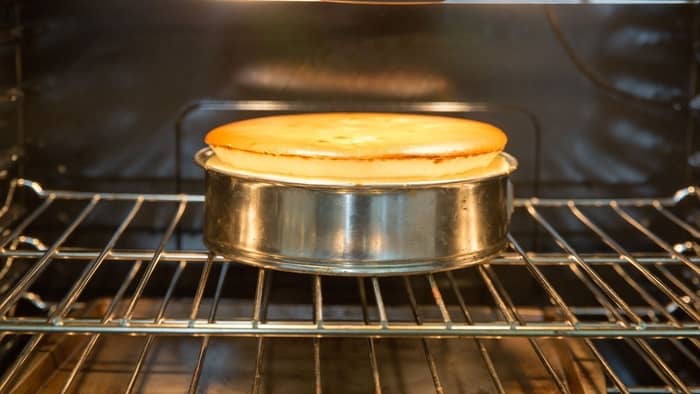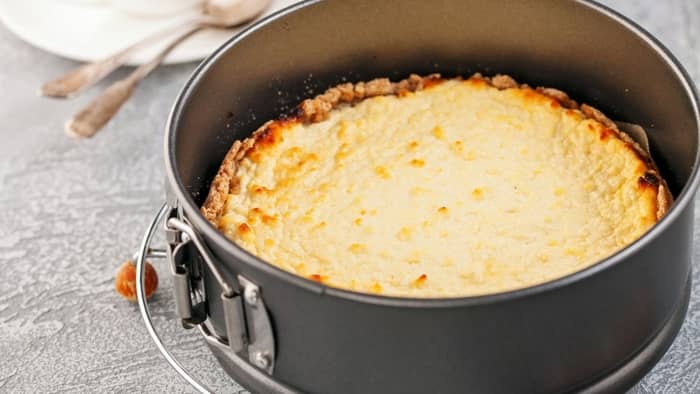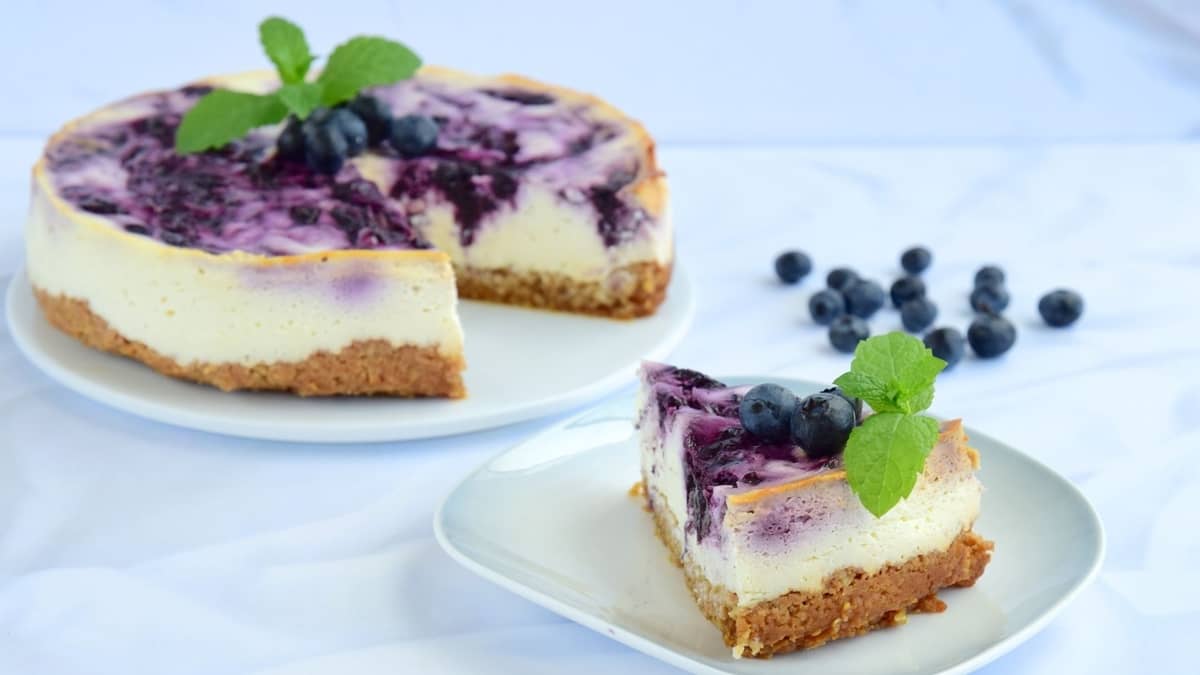By Zarah Grace, last updated on January 10, 2025
People can hardly say no to cheesecakes, no matter what flavor of cheesecake. But what if my cheesecake is runny in the middle?
But first, keep in mind that baking your homemade cheesecake at home is fun and rewarding; however, it can be tricky, especially knowing if you baked the cheesecake thoroughly.
Also, signs of an undercooked cheesecake are; first, it is too runny. Second, it will sink in the middle, and third, it will be incapable of retaining its form. To achieve that perfect, soft, creamy, and luscious texture in cheesecakes, you must learn a few tips and tricks.
How To Tell If a Cheesecake is Undercooked – 5 Tips
Like any other dessert, you need to cook cheesecakes to perfection. In that regard, keep in mind the right ingredients, measurements, and baking time. These three factors are crucial to have perfect results. Undercooked cheesecakes are runny, hard to serve, and unappetizing to look at. And unpleasant to eat. Here are some methods to know if you have an undercooked cheesecake.
Tip #1: Use an instant-read cooking thermometer
Checking the cheesecake’s temperature using an instant-read cooking thermometer is one of the easiest and fool-proof ways. Do this to know if you have an undercooked cheesecake.
In addition to that, this kind of thermometer is preferable. Because of this, you do not have to wait for several minutes to know the temperature of your cheesecake. Thus, saves time and also prevents your cheesecake from overbaking.
With that, use a clean and calibrated thermometer. And stick it halfway through into the middle of your cheesecake. Then, refrain from pushing it all the way down to your pan. Also, the thermometer should read 150 degrees Fahrenheit when poked in the middle of your cheesecake.
Once you reached my cheesecake is runny in the middle, take your cheesecake out of the oven. Afterward, let it cool completely in a cooling wire rack. If you did not reach the temperature, make sure to bake your cheesecake in the oven for another 5 minutes. Then, repeat this process if needed until you can get the right temperature.

Tip #2: Jiggle test
If your cheesecake jiggles too much, then there is something wrong. If it jiggles too little, then there is something wrong as well. A perfectly baked cheesecake must have the right amount of jiggle. To test your cheesecake, you can do these tests if it has the right amount of jiggle.
Moreover, wear a pair of oven mittens. And place both of your hands on each side of the baking pan. Then, carefully give the cheesecake a little shake. Also, avoid being rough on your cheesecake, as it may cause cracks.
Next, check the middle of your cheesecake and observe how much it jiggles. Suppose you can locate a 2-inch area in the middle of your cheesecake. Likewise, it slightly jiggles; you have a perfectly baked cheesecake.
However, suppose your cheesecake has a larger jiggling area than 2 inches. And you spot an uncooked batter that breaks through the surface. Likewise, spilling over the edges of your baking pan. In that case, this indicates that you have an undercooked cheesecake.
In that regard, ensure to bake your cheesecake again for another 5 minutes if your cheesecake is completely firm. And it does not jiggle in any way; it indicates that you have an overcooked cheesecake.
Tip #3: The toothpick test
This method is the simplest for testing the doneness of your cheesecake but not the most accurate. That is why it is a last-minute option when you do not have a cooking thermometer.
The same with a thermometer; you either stick or poke the toothpick into the middle of the cheesecake. However, you need to rely on your observation and evaluation skills rather than a specific reading. Here are some steps to use a toothpick to check if you have an undercooked cheesecake:
- Make sure to stick a clean toothpick in the center of your cheesecake. Afterward, poke the center of your cheesecake only halfway through. Make sure to pull it after a few seconds.
- Then, check the toothpick to see if there is any residual batter on it. If you observe that your toothpick has dripping liquid on it, it indicates that you have an undercooked cheesecake. If the toothpick is completely dry or comes out clean, you successfully baked the cheesecake through.
Remember, if you have an undercooked cheesecake, bake it for another 5 minutes. And check it again using a toothpick. To avoid ruining your cheesecake, use the same hole you used before when poking.
Tip #4: Middle of cheesecake not cooked: Pressure test
For this method, you will be using only your fingers. This method will require you to be gentle to avoid ruining or cracking the surface of your cheesecake. To do this:
- Properly wash your hands using warm water and soap to ensure they are clean. Avoid leaving soap residue on your hands and dry them completely.
- Then, use one or two fingers and gently touch the middle part of your cheesecake.
- With that, avoid pressing too hard. If your finger sinks into the middle and batters stick to it, then you have an undercooked cheesecake. Afterward, bake it in the oven for another 5 minutes before checking out again using this method.
Tip #5: Observing browning edges
In this method, you can compare an undercooked cheesecake to a perfectly baked one by looking at it. The edges of the cheesecake cook before the center. When half an inch ring around the edges of your cheesecake starts to turn golden-brown. And become a little puffy, and its center remains pale and a tad jiggly. It means that your cheesecake is ready.
However, if the middle of your cheesecake is still fluid, then you have an undercooked cheesecake. So with that, you need to bake it again. Also, If your cheesecake is still shiny, then you have an undercooked cheesecake. Keep in mind that a perfectly baked cheesecake has lost all its shine.

How To Fix a Cheesecake That Didn’t Set?
Fixing an undercooked cheesecake is tricky, so here are a few methods to fix an undercooked cheesecake.
Allow it to rest
Cheesecake requires time to set and has a longer cooling period than other desserts. Sometimes all it requires is time and rest. The perfect way to cool off your cheesecake is to leave it inside the refrigerator. Make sure to do this for a couple of hours and even overnight before serving. During this process, the middle of your cheesecake becomes firmer. With that, allow your cheesecake to cool down before placing it inside the refrigerator.
Water bath or bain-marie
Bain-marie is a common method in baking to ensure that you cooked your desserts evenly without surface cracks. If you like a creamy cheesecake with a perfect texture, then I recommend using a bain-marie.
In that regard, wrap your baking pan in foil. Then, place it inside a bigger pan with hot water. Because of that, ensure not to fill it with too much water; an inch of hot water is enough.
Also, this technique produces the creamiest cheesecakes and fixes undercooked ones. Even though this technique proves successful at times, never re-bake your cheesecake. The main reason is that the chances of ruining it are very high.
After leaving your cheesecake in the refrigerator overnight, and if it did not set, take it out and let your cheesecake reach room temperature. Then, prepare your bain-marie and place your cheesecake inside. After that, set your oven to a low to moderate temperature to avoid overcooking your cheesecake.
Slow Cooking
Another option for you is to simply put your cheesecake back in the oven; however, be extra careful not to overbake it. To do this, set your oven at a low temperature. Afterward, allow your cheesecake to slow-cook to reach 150 degrees Fahrenheit in the center. With that, the process should not take longer than 15 to 30 minutes. Finally, make sure to check every 5 minutes.

Zarah is an experienced pastry chef whose creations have delighted countless customers. With a passion for baking, Zarah has developed a unique style that combines classic techniques with modern flavors. Her desserts are always made with the freshest ingredients, and her attention to detail shows in her beautiful and delicious creations. Zarah has a wealth of experience in the pastry kitchen, and loves to share her knowledge with others. Whether it is teaching a class or creating a custom cake for a special occasion, Zarah is committed to making sure every customer is satisfied.

